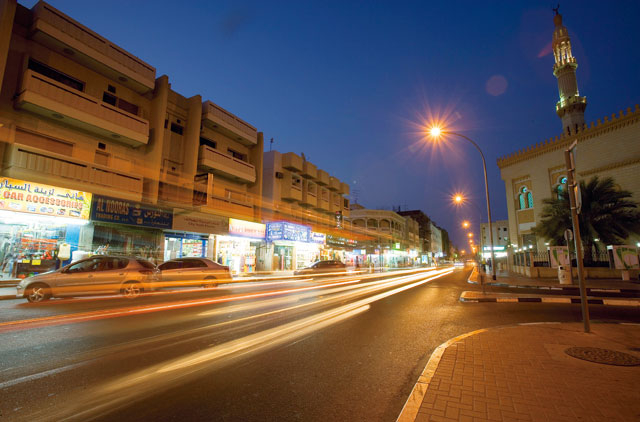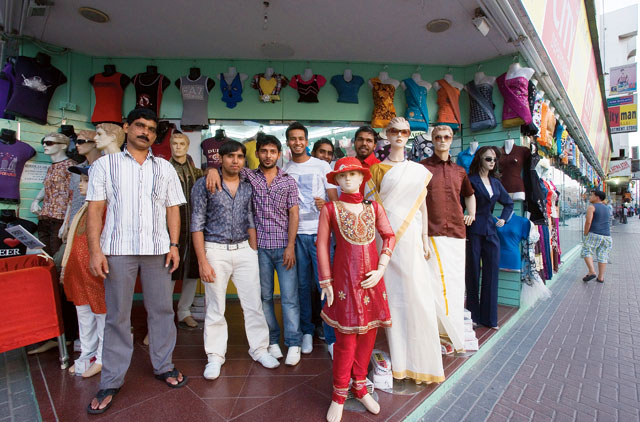
The concept model for Jumeirah Garden City is enormous in its own right. About the size of a large boardroom table, the model depicts an assortment of gleaming towers looming over a swath of lushly landscaped and highly geometric urban planning. One's eye is drawn immediately to three glass-clad edifices that rise more than 600 metres from a shared base, interconnected by a network of suspension style sky-bridges. In detailed drawings, the bridges are open to the heavens, revealing park-like public spaces among the clouds; a fitting ode to the singular ambition and optimism that marked Dubai's property market circa 2008.
Today, these futuristic towers, which were supposed to stride over Satwa, one of the oldest neighbourhoods in Dubai, remain consigned to the realm of the possible. The redevelopment of Satwa as a freehold zone, however, continues to hold great potential, partly because of the existing neighbourhood. "If this location is offered as a freehold option, no doubt it will have [an] edge over other locations as the infrastructure is well developed. The bigger question will be where in Satwa this option will be offered... we're sure that when this offering is made in the marketplace it will be well received," says Vineet Kumar, head of leasing and sales at Asteco Property Management Dubai.
But the fact remains that as the property market contracted in 2009, Jumeirah Garden City developer Meraas altered its course, adopting a wait and watch approach with the following statement: "Shifting away from the fast track development of its Jumeirah Gardens project, and in light of the rapid change in the real estate market and global economic conditions, Meraas Development is now focusing on adapting its master plan, designs and product mix to suit market conditions... Meraas is well poised to accelerate its development upon stabilisation of the real estate market."
The contrast
And so Satwa still stands, teeming with life and activity; part of the Dubai that you almost never see in the international press.
Stabilisation may not come for some time, as the latest Landmark Advisory report predicts that new inventory is expected to drive vacancy rates up to a potential high of 28 per cent by 2012. In the shadow of Jumeirah Garden's uncertain fate, the neighbourhood it was once set to replace remains a living testament to a more time-worn, yet frenetic and bustling version of Dubai. Satwa even merited a visit from the influential US travel show, No Reservations with Anthony Bourdain, in which Bourdain, a former chef and author of the best-selling book Kitchen Confidential visited one of Satwa's most visible culinary treasures: Ravi's Restaurant. In the same episode Bourdain also visited the Burj Al Arab, Dubai's super luxurious hotel, signalling that old Dubai and new Dubai could both invite tourism, as both elements combine to create the contrast that makes Dubai so interesting.
Not all of Satwa was spared from the bulldozer's blade though; many villas were knocked down before the project went on hold, with residents often learning of their home's demise when they returned one day to find an ‘X- spray-painted across their front door. And yet others, who had dutifully moved out of condemned structures, were later allowed to move back into their homes. Amid all this confusion, with its commingling sense of loss and reprieve, Satwa endures.
Callan Emery and his family have lived in Satwa for years, and they won't be leaving if they can avoid it. In 2009, the house they were leasing in Delta Village, near Ravi's Restaurant was marked for demolition. The family gave up their place in the heart of things, ‘the real Satwa experience,' as they call it, moving to a villa on the Al Bada'a side, which the Emery's semi-jokingly refer to as the ‘posh end.' They're paying a lot more now, and while their old home was ultimately spared from destruction, they weren't able to move back in. And yet they're still living in their favourite part of Dubai: "I like the hustle and bustle," explains Callan, "I can find pretty much anything I'm looking for and can get it at really reasonable and negotiable prices."
With midday temperatures in the 40s, Satwa, like many other Dubai neighbourhoods, seems to come alive on summer nights. As the hot drowsy day fades into darkness, Satwa's colourful and eclectic store fronts glow with various shades of fluorescent and neon, as people in sundry international garb make their way through the evening air. In one block you might pass a plumbing supply store, a barber's shop, a pet store, or a venue whose inventory defies description. With Dubai's surfeit of gleaming retail options, it's places like Satwa that fill in the cracks in an otherwise overwhelming barrage of consumer goods. At odd intervals, Satwa's retail chaos assembles into order, where several building supply shops line up in a row, competing for your dirhams in close proximity. Here even order can seem something of an accident, and Satwa is all the more alive and exciting for it.
Cultural flavour
Jason Rezaian, a Tehran-based journalist and entrepreneur, always seeks out Satwa on his frequent visits to Dubai: "Satwa for me defines all that is right about Dubai," explains Rezaian. "All those who would have you believe that nothing existed here before the malls and towers need only to stroll down the avenues in Satwa and breathe in all the cultures that have been commingling there now for decades." As a visitor, Rezaian takes full advantage of the neighbourhood's culinary and grooming bargains... his three favourite Dubai businesses are all based in Satwa: "Ravi's, Al Mallah, and the Diva Gents Salon. I can get a great curry, wash it down with fantastic fresh-squeezed juice and then have my nostrils waxed all in one affordable trip." While a redeveloped Satwa might offer these same services, it's fair to say that the prices, products and atmosphere would be hugely different.
Merly, a 20-year resident of Satwa, can't imagine Dubai without her adopted home: "I don't think so, its jut too difficult to imagine" she says cheerily. Merly works at Book World, one of Satwa's many scruffy, downmarket treasures. With just a handful of used bookshops in the entire emirate, Book World's assortment of dog-eared offerings testifies to the enduring value of things potentially cast aside. Speaking to Merly on the phone, I picture her behind the counter at the shop, walled in by books on either side: "Satwa can sometimes feel like a small city in the Philippines," she says. "Walk down my street and you'll hear a mixture of Tagalog and English among other languages. But it wasn't always like that. When I came to Satwa in 1986, there were fewer people here in general, and we'd get so excited whenever we saw a fellow Filipino that we would wave excitedly; it was such a rare occasion." As Satwa grew, sections of the neighbourhood took on a large Filipino population, formulating what Merly refers to as "Little Manila", a place that has become a sort of proxy for her own country: "Dubai feels like home now, and this neighbourhood is the next best thing to actually moving home, which I won't do until I'm older." Merly's two boys were born here, and for her the neighbourhood is full of memories and promise. "I used to get up early to walk to the beach each day. The great thing about Satwa is that it's one of the few places where you can stroll around without one penny in your pocket and still have a nice time."
Low vacancy
Rents in Satwa run the gamut from Dh35,000 for a small studio, to three-bedroom luxury apartments priced at Dh170,000, to large four-bedroom villas commanding Dh240,000. Prices vary by location and quality, but one constant encountered in researching this article is that there's actually very low vacancy in Satwa as measured by listings; none of the agencies we spoke to had anything to show. In part, this may because those units that were demolished have effectively increased demand. But in that story is a message of resilience; Satwa enjoys a high level of loyalty amongst its inhabitants, who told me over and over again that they have a hard time imagining life outside their chosen neighbourhood.
"Satwa is part of Dubai's heritage, Emery told me: "If it were to be knocked down it would be a sad loss as there is really very little of the old Dubai remaining." Which is why Emery and countless others like him are staying put; those who love Satwa want to enjoy it as long as it lasts, however long that may be.
35k
Rentals (in dirhams) for a studio in Satwa.




